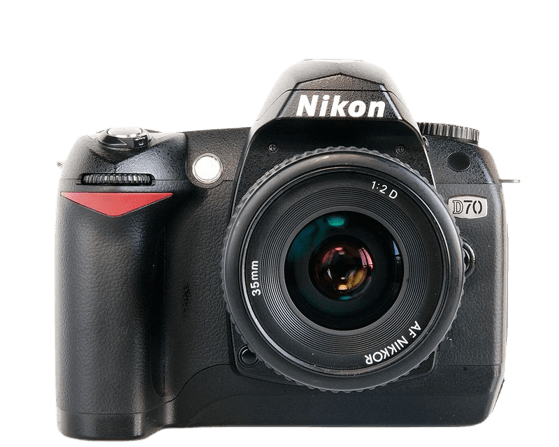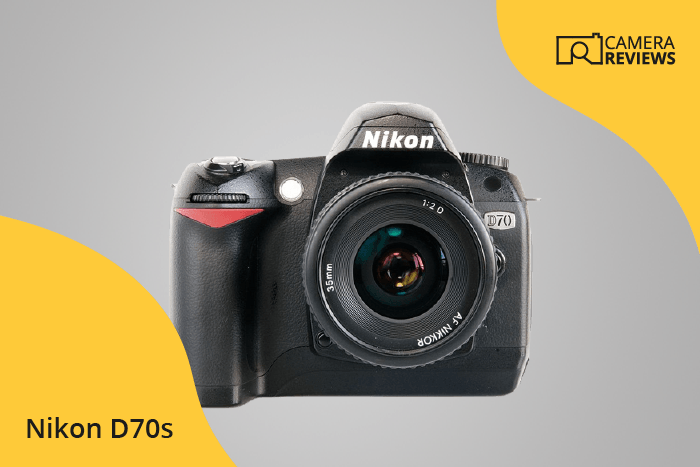Nikon D70s Specs and Scores

The Nikon D70s scores 29/100 in our evaluation, which reflects its general specifications. Launched in 2005 at a price of $700, this DSLR camera measures 140 x 111 x 78mm and weighs 679g (1.50lbs). Considering its age, the D70s may not compete with modern cameras in terms of features and performance. However, it still holds value for those seeking a budget-friendly option or a beginner-friendly DSLR. The specifications, while dated, offer a solid foundation for those new to photography.
Nikon D70s Overview and Optics
The optics of the Nikon D70s receive a score of 35/100. This camera has 6.1 megapixels, a shooting speed of 3, and a CCD sensor. It uses the Nikon Image processing engine and has a DXOMARK score of 50 for the sensor. The sensor size is APS-C and the lens mount is Nikon F DX. The Nikon D70s does not have image stabilisation and has an aspect ratio of 3:2.
Comparing these specifications to today’s market, the Nikon D70s falls short in many areas. Modern cameras typically have higher megapixels, faster shooting speeds, and better image stabilisation. The D70s’ sensor and processor also lag behind current standards, contributing to its lower score.
Despite these drawbacks, the Nikon D70s may still appeal to some users due to its simplicity and compatibility with Nikon F DX lenses. However, for those seeking advanced optics and features, it is advisable to consider more recent camera models.
Nikon D70s Video Performance
The Nikon D70s lacks video capabilities. This camera only captures still images.
Nikon D70s Features and Benefits
The Nikon D70s scores a 10/100 in the features department. With a 2-inch screen size and a resolution of 130,000 dots, the display is small and of low quality compared to modern cameras. It lacks a touchscreen, flip screen, and GPS capabilities, further limiting its appeal to contemporary users.
However, the Nikon D70s does possess Wi-Fi connectivity, which allows for easier sharing and transferring of images. Unfortunately, it does not offer Bluetooth compatibility, which is another feature commonly found in current camera models.
When compared to today’s cameras, the Nikon D70s falls short in terms of features. Its small, low-resolution screen and lack of advanced functionalities make it less appealing for those seeking a modern, feature-rich camera. While the Wi-Fi connectivity is a positive aspect, the absence of other essential features makes it difficult to recommend the Nikon D70s in today’s competitive market.
Nikon D70s Storage and Battery
The Nikon D70s receives a storage and battery score of 43 out of 100. This camera features a single memory card slot, accepting Compact Flash (Type I or II) cards. Compared to modern cameras that often provide multiple slots and support for SD cards, the D70s falls short in storage options.
Regarding battery life, the Nikon D70s offers 950 shots per charge using the EN-EL3a battery. This performance is respectable even by today’s standards. However, the lack of USB charging limits the convenience and versatility of powering the camera.
Taking these specifications into account, the Nikon D70s’ storage and battery capabilities are adequate but not exceptional in the current market. The camera’s limitations in storage options and charging methods hinder its competitiveness among more recent models.
Nikon D70s Alternatives
Do you want to know how the Nikon D70s compares to its competitors? Have a look at the most popular comparisons for this camera below:
- Canon EOS 70D vs Nikon D70s
- Nikon D7000 vs D70s
- Nikon D70s vs D7200
- Nikon D70s vs Panasonic Lumix DC-G9
- Canon EOS 1D Mark II N vs Nikon D70s
- Canon EOS 1D X vs Nikon D70s
Nikon D70s FAQ
Does the Nikon D70s Have Built-in Image Stabilization?
The Nikon D70s does not have built-in image stabilization. However, you can use lenses with VR (Vibration Reduction) technology to help minimize camera shake and improve image sharpness.
Does the Nikon D70s Support 4K Video Recording?
The Nikon D70s does not support 4K video recording, as it is primarily a still photography camera without video functionality.
What Size Sensor Does The Nikon D70s Have?
The Nikon D70s features an APS-C sized sensor, which is smaller than a full-frame sensor but larger than a Micro Four Thirds sensor, providing good image quality and performance.
Does the Nikon D70s Have a Dual Memory Card Slot?
The Nikon D70s does not have a dual memory card slot. It has a single CompactFlash (CF) card slot for storing images.
Does the Nikon D70s Have a Touch Screen?
The Nikon D70s does not have a touch screen. It features a 2-inch LCD screen for menu navigation and image review, but it is not touch-sensitive.
Does the Nikon D70s Have Wi-Fi and Bluetooth?
The Nikon D70s has built-in Wi-Fi for wireless image transfer and remote control, but it does not have Bluetooth connectivity.
Does the Nikon D70s Have GPS?
The Nikon D70s does not have a built-in GPS feature for geotagging images or tracking location information.
Is the Nikon D70s Weather Sealed?
The Nikon D70s is not weather sealed, so it is not recommended for use in harsh weather conditions or environments with dust and moisture.
Does the Nikon D70s Have a Built-in Flash?
Yes, the Nikon D70s has a built-in flash that can be used for fill light or as a commander for compatible external flashes.

